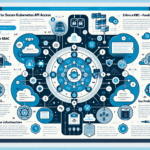Managing Kubernetes secrets effectively is crucial to maintaining the security and integrity of your applications and infrastructure. Here are the best practices for handling Kubernetes secrets:
1. Use Kubernetes Secrets Object
- Store sensitive information like passwords, API keys, and certificates in Kubernetes
Secretobjects rather than embedding them directly in configurations or environment variables. - Secrets are base64 encoded, not encrypted by default, so additional measures are required for securing them.
2. Enable Encryption at Rest
- Configure Kubernetes to encrypt secrets at rest using an encryption provider (e.g., AES-256). This ensures that even if the etcd database is compromised, secrets remain secure.
- Update the
EncryptionConfigurationfile in the Kubernetes API server configuration.
yaml
kind: EncryptionConfiguration
apiVersion: apiserver.config.k8s.io/v1
resources:
- resources:
- secrets
providers:
- aescbc:
keys:
- name: key1
secret: <base64-encoded-key>
- identity: {}
3. Restrict Access Using RBAC
- Use Role-Based Access Control (RBAC) to limit who can view, create, or modify secrets. Define roles and role bindings carefully to ensure secrets are only accessible to authorized personnel and services.
- For example, create a role that grants access only to specific secrets:
yaml
kind: Role
apiVersion: rbac.authorization.k8s.io/v1
metadata:
namespace: default
name: secret-reader
rules:
- apiGroups: [""]
resources: ["secrets"]
verbs: ["get"]
4. Avoid Hardcoding Secrets
- Do not hardcode secrets in application code, deployment manifests, or container images. Instead, reference secrets through environment variables or volume mounts.
Example: Mounting a secret as an environment variable in a pod:
yaml
env:
- name: DB_PASSWORD
valueFrom:
secretKeyRef:
name: db-secret
key: password
5. Use External Secret Management Tools
- Integrate Kubernetes with external secret management tools like HashiCorp Vault, AWS Secrets Manager, Azure Key Vault, or Google Secret Manager. These tools provide better security, auditing, and lifecycle management.
- Use solutions like
External Secrets Operatorto sync secrets from external systems to Kubernetes.
6. Implement Secret Rotation
- Regularly rotate secrets to minimize the impact of accidental exposure or compromise. Automate secret rotation using external secret managers or custom scripts.
- Ensure that applications can dynamically reload updated secrets without requiring downtime.
7. Audit and Monitor Secrets Usage
- Continuously audit access to secrets using Kubernetes audit logs or external logging solutions.
- Monitor for unauthorized access or suspicious activity using tools like Prometheus, Grafana, or third-party security monitoring solutions.
8. Avoid Plaintext Secrets in CI/CD Pipelines
- Do not expose secrets as plaintext in CI/CD pipelines. Use secret management tools or Kubernetes secrets injection mechanisms to securely pass sensitive data to build and deployment processes.
9. Limit Secret Exposure in Logs
- Ensure applications and Kubernetes components do not log sensitive information inadvertently. Configure logging systems to scrub secrets from logs.
10. Secure Secrets in Transit
- Use TLS/SSL to encrypt communication between Kubernetes components and applications to prevent interception of secrets during transit.
11. Namespace Isolation for Secrets
- Organize secrets by namespace and ensure they are isolated between applications or teams to reduce the blast radius in case of a compromise.
12. Use Immutable Secrets
- When possible, mark secrets as immutable. This prevents accidental or malicious modification of the secret once it’s created.
yaml
kubectl create secret generic my-secret --from-literal=username=admin --from-literal=password=secret --immutable=true
13. Backup Secrets Securely
- Back up secrets as part of your etcd backup process. Ensure the backups are encrypted and stored in a secure location.
14. Delete Unused Secrets
- Regularly audit and clean up unused secrets to reduce clutter and minimize potential attack surfaces.
15. Leverage Tools for Secret Management
- Use tools like
kubectl,kustomize, or Helm charts to manage secrets securely and consistently across environments.
By following these best practices, you can ensure the security and proper management of Kubernetes secrets, reducing the risk of exposure and maintaining the integrity of your infrastructure.





